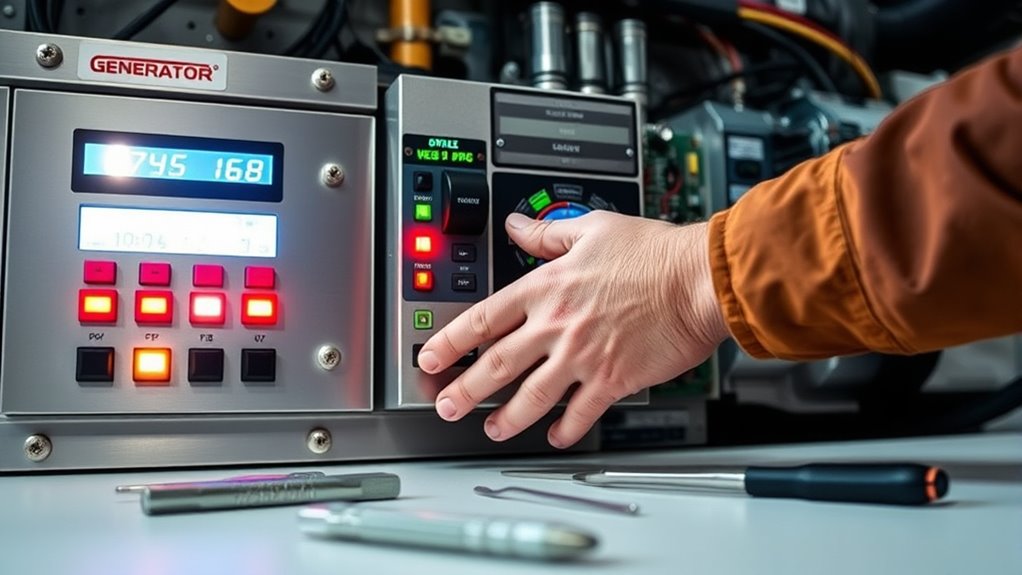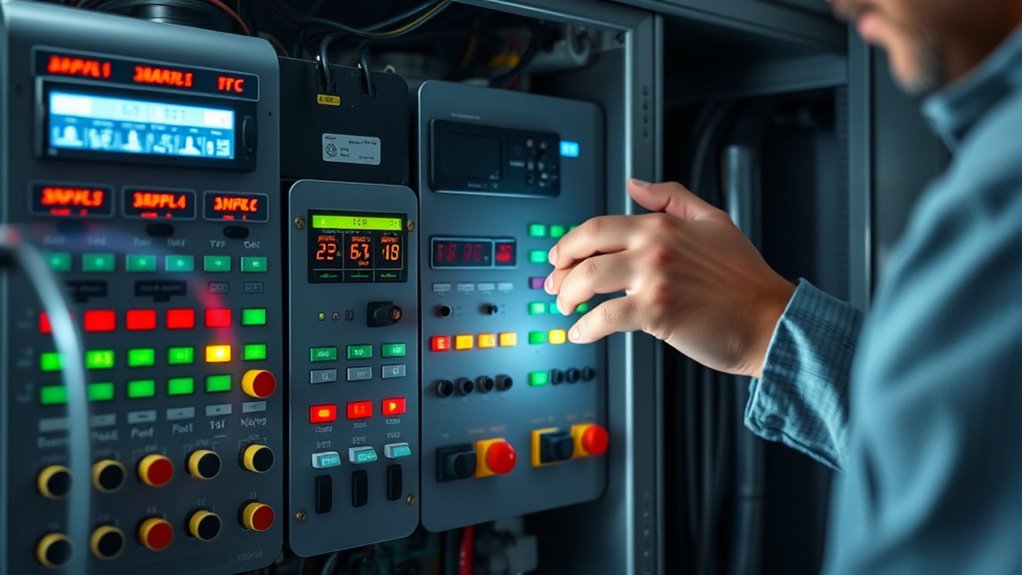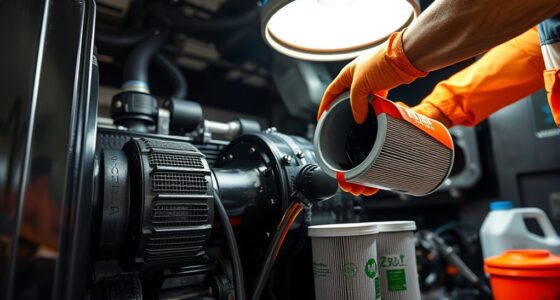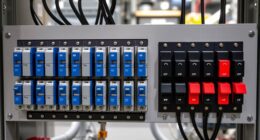To maintain your generator control panels, you should perform regular inspections for physical damage, dirt, or moisture and keep the panels clean and well-ventilated. Schedule routine updates of firmware and software to guarantee peak performance and security. Use remote diagnostics to monitor system health in real-time and catch issues early. Keep detailed maintenance logs and stay trained on troubleshooting basics. Staying proactive helps prevent costly failures; continue exploring more tips to keep your system running smoothly.
Key Takeaways
- Conduct regular visual inspections for physical damage, dirt, and moisture to ensure panel integrity.
- Perform routine firmware and software updates to enhance security, functionality, and remote diagnostics.
- Check connections and wiring for looseness or corrosion to prevent operational issues.
- Utilize remote diagnostics for real-time monitoring and early problem detection.
- Train personnel on troubleshooting techniques and maintain detailed maintenance logs for ongoing reliability.

Are you guaranteeing your generator control panels are properly maintained? Regular upkeep is essential to keep your system running smoothly and prevent costly failures. One of the most effective ways to stay ahead is by leveraging remote diagnostics. This technology allows you to monitor your control panels from anywhere, providing real-time data on system performance and alerting you to potential issues before they escalate. Remote diagnostics can identify irregularities such as voltage fluctuations, temperature anomalies, or communication errors, enabling you to address problems promptly. This proactive approach minimizes downtime and extends the lifespan of your generator system. Proper inverter generator maintenance is also crucial to ensure optimal performance and reliability over time.
Utilize remote diagnostics for real-time monitoring and early issue detection of your generator control panels.
Panel troubleshooting is another critical aspect of maintenance that shouldn’t be overlooked. When you encounter a malfunction, quick identification and resolution are fundamental. Familiarize yourself with the common signs of trouble, such as irregular readings, warning lights, or inconsistent operation. If you notice these signs, start by checking the control panel’s connections and inspecting for loose wires or corrosion. Many issues can be resolved through simple resets or adjustments, but don’t hesitate to consult the manufacturer’s troubleshooting guide for specific procedures. Proper troubleshooting not only restores normal operation faster but also helps you understand your system better, reducing the likelihood of future problems.
Maintaining your control panels also involves routine inspections. Regularly check for physical damage, dirt, or moisture that could impair functionality. Keep the panels clean and dry, and ensure ventilation is unobstructed. These simple steps can considerably improve the longevity of your equipment. Additionally, update your control panel firmware and software as recommended by the manufacturer. Software updates often include security patches, performance improvements, and new features that enhance remote diagnostics capabilities. Staying current ensures your system benefits from the latest advancements in technology and security.
Training your team on basic troubleshooting and remote diagnostics procedures is equally important. Well-trained personnel can quickly respond to alerts, perform initial diagnostics, and determine when professional repair is needed. This knowledge reduces reliance on external technicians for minor issues and keeps your operations running without unnecessary delays. Always keep a detailed maintenance log, documenting inspections, repairs, and software updates. This record helps track recurring issues and plan preventative measures more effectively.
Frequently Asked Questions
How Often Should Control Panel Firmware Be Updated?
You should update your control panel firmware whenever manufacturers release new firmware updates or software patches. Regular updates guarantee your control system stays secure, efficient, and compatible with other equipment. Typically, check for updates at least every three to six months, or sooner if you notice performance issues. Staying current with firmware updates helps prevent vulnerabilities and improves your generator’s reliability, keeping everything running smoothly and safely.
What Are Common Signs of Control Panel Malfunction?
About 60% of control panel malfunctions show early signs, so you should watch for irregularities. Common signs include unexpected error messages, erratic indicator lights, or unresponsive controls. Regular control panel diagnostics help detect electrical component wear before failure occurs. If you notice these issues, address them promptly to prevent generator downtime. Staying vigilant guarantees your system remains reliable and efficient, saving you time and costly repairs down the line.
How to Troubleshoot Intermittent Generator Control Panel Issues?
When troubleshooting intermittent control panel issues, start with control panel diagnostics to identify underlying problems. Follow troubleshooting procedures systematically, checking for loose connections, faulty wiring, or worn components. Use a multimeter to test voltage levels and inspect relays or circuit boards for damage. Document your findings and test after each step. This focused approach helps pinpoint irregularities and guarantees your generator control panel operates reliably and efficiently.
Are There Specific Safety Precautions for Panel Maintenance?
You should always prioritize electrical safety during panel maintenance, as studies show proper precautions substantially reduce risks. Before starting, verify the generator is disconnected and grounded. Wear appropriate PPE, like gloves and safety glasses, and avoid working in wet conditions. Regular preventive maintenance includes inspecting for damaged wiring or loose connections. These steps help prevent accidents, ensuring your safety and the reliable operation of the control panel.
What Is the Typical Lifespan of a Generator Control Panel?
The typical lifespan of a generator control panel ranges from 10 to 15 years, depending on control panel durability and usage. Factors like environmental conditions, electrical loads, and maintenance practices considerably influence its lifespan. You can extend its life by performing regular inspections, keeping it dry and clean, and addressing issues promptly. Proper care ensures reliable operation and maximizes the control panel’s durability over time.
Conclusion
By diligently diagnosing, detailing, and directing your generator control panels, you ensure their endurance and efficiency. Regular inspection and prompt prevention prevent problems from piling up, protecting your power supply and peace of mind. Stay steadfast in your service, stay sharp in your scrutiny, and sustain your system’s strength. Remember, consistent care creates a confident, cost-effective, and corrosion-free control, vital for continuous, carefree operation. Keep your control panel’s condition compellingly clean and current—your generator’s guardian depends on it.









